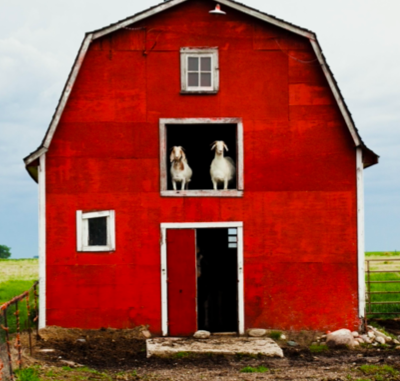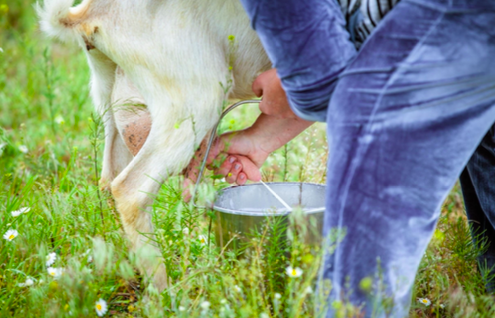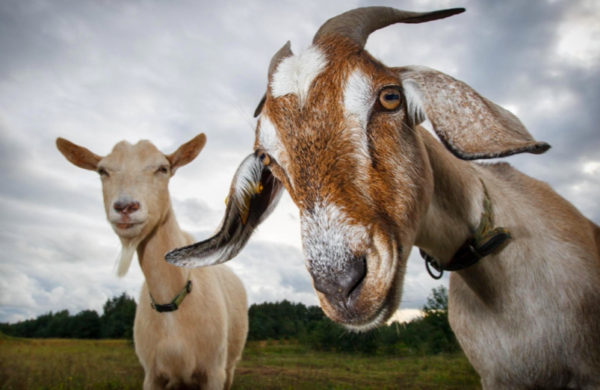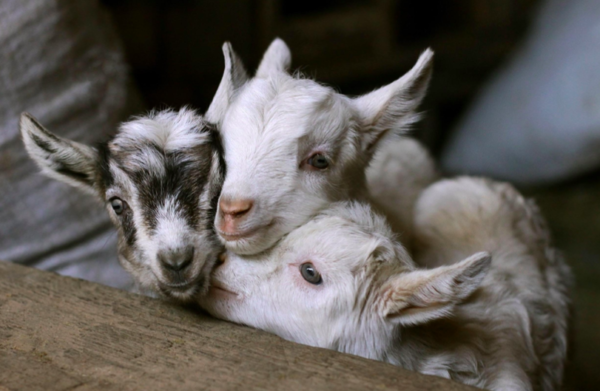
Kathleen Miller
Sustainable living, gardening, and farming is based on an understanding of ecosystems and the study of relationships between organisms and their environment. It has been defined as an integrated system of plant and animal production practices that will last over time. Having a harmonious relationship with Gaia (Mother Earth) provides food for people, enhances the natural environment upon which the community depends, makes efficient use of resources, and integrates natural cycles that sustain economic viability as well as enhances the quality of life for the community as a whole.
Got Goat’s Milk?

Goats have been used for milk, meat, fur, and skins across much of the world for centuries. Milk from goats is often turned into goat cheese. Female goats are referred to as does or nannies, intact males are called bucks or billies, and young goats of both sexes are called kids.
Castrated males are called wethers. Goats fit perfectly into self-sustaining farms in places where other livestock would not thrive. Five goats can live off the area that one cow needs, so you can see why goats are popular worldwide.
Goats are tough survivors, and this makes them hardier than most creatures. Dairy goats can produce three to four quarts of milk per day, making them an excellent choice if you are looking for a dairy animal for a small-sized sustainable farm or ranch. They are easy to handle, smaller than cows, charming, and quick-witted. Dairy goats can produce three to four quarts of milk per day. Their milk is as nutritious as cow’s milk.
Goat’s milk is naturally homogenized, which means the cream does not separate from the rest of the milk, making it easier to digest. Goat’s milk is less likely to provoke an allergic reaction than cow’s milk. Dairy goats have always fit well on small-scale sustainable farming enterprises.
The most important part of buying a dairy goat is milk production. It is best to start by buying a milking doe that is already producing milk and has a good production record. The breed you choose will depend on how you will use the milk, the breed’s availability in or near your area, and personal preference. Therefore, it is important to select breeds that possess the characteristics you need. Production records are the best way to find this information.
If you want to buy a young female, its mother and sisters’ production will indicate how much milk you can expect. Before you buy a milking doe, make sure you know how to milk it correctly. If you fail to empty the udder at each milking, milk production will slow down and even stop completely. If this happens, the doe will give no more milk until it bears another kid.
Male goats are called bucks and are not usually kept near the does. Bucks have a powerful nasty smell that can easily taint the flavor of the doe’s milk.

Good quality forage will satisfy almost all the nutritional needs of non-milking does. Goats are ruminants, unlike cows and sheep, so pasture should include various leaves, weeds, and grasses to provide essential vitamins and minerals. Legumes in alfalfa hay are also needed as they provide the necessary protein.
When pastures are unavailable, feed well-cured hay. Goats will not eat hay off the ground, so make sure to put the hay in a feed rack. Milking does need the additional protein of a mixed grain supplement in their diet. They require between two and four pounds of grain per day spaced out to be fed twice a day.
Overfeeding grain is dangerous and can lead to poor digestion of roughage and, in extreme cases, cause bloat, a serious buildup of gases that can cause death. To prevent overeating, feed the grain only after the goats have eaten plenty of grass or hay. A goat’s stomach can be disturbed by changes in its diet, so feed your goats at the same time each day and introduce feed changes slowly.
This is especially important to remember when transitioning your goats from winter hay to spring pasture. Make sure to always provide your goats with plenty of fresh, clean water.

Goats should always have access to shade and shelter from bad weather. Shelters for your milking goats should be simple, draft-free, and have plenty of bedding. Goats do not mind cold weather but can get sick from drafts. Provide them access to a fenced outdoor area for exercising or pasture. The fencing must be at least four feet high, even higher for especially agile and mischievous goats. Goats must be pastured on the well-drained ground to prevent foot rot. All goats like to climb on rocks and boulders, which will help them keep their feet trimmed naturally.
For herds larger than fifteen, it is often more economical and practical to machine milk. Milking machines for small-scale operations are available from goat supply companies. Dairies with more than fifty goats will require a large milking parlor designed for compliance with regulations. Hand milking is efficient for herds of up to twelve goats. Hand-milkers use a stainless-steel pail with a hood or cover to keep out debris.
A good time to feed grain is when they are being milked, which keeps the doe happily distracted and calm. Using a milking stand provides several benefits. It keeps the doe standing still and also puts the doe at a comfortable height for the milker. You must maintain sanitary practices, from cleaning the teats before milking to handling the milk. And remember to make sure you always clean your milking equipment properly and your milking parlor sanitary.
Support Northern Colorado Journalism
Show your support for North Forty News by helping us produce more content. It's a kind and simple gesture that will help us continue to bring more content to you.
BONUS - Donors get a link in their receipt to sign up for our once-per-week instant text messaging alert. Get your e-copy of North Forty News the moment it is released!
Click to Donate
